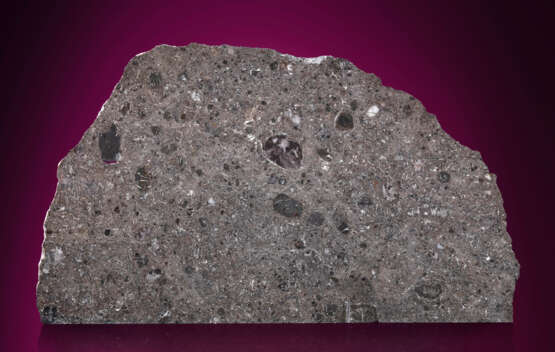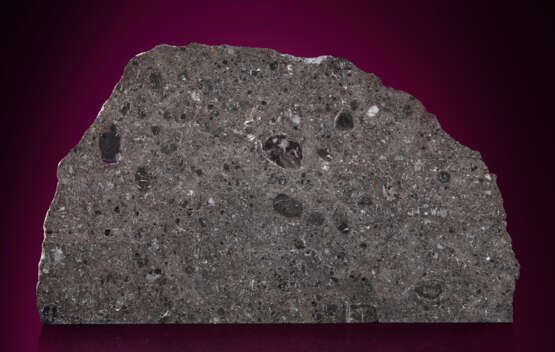ID 716425
Lot 40 | TISSERLITINE 001 — LARGE PARTIAL SLICE OF THE MOON
Estimate value
$ 70 000 – 100 000
Less than 750 kg of lunar meteorites are known to exist. All would fit within five large foot lockers and a significant portion of these rocks is controlled by governmental institutions. And while Apollo astronauts returned with 382 kg of Moon rocks, not one gram of this material is available for private ownership.
Scientists identify Moon rocks by their specific textural, mineralogical, chemical and isotopic signatures. Many of the common minerals found on Earth’s surface are rare or absent on the Moon and some lunar minerals are unknown on Earth. In addition, Moon rocks contain gases captured from the solar wind with isotope ratios very different from those same gases on Earth. The research scientist who analyzed these samples, Dr. Anthony Irving, is the world’s most renowned classifier of meteorites from the Moon and Mars.
Because lunar samples are extremely uncommon, and large lunar samples exceedingly so, it was decided to subdivide the largest mass into slabs primarily for museum distribution.
As a result of the ongoing pulverization that occurred on the Moon’s surface from asteroid and comet bombardment, different degrees of brecciation and melting are seen in lunar samples. Now offered is a novel presentation — no other lunar samples look quite like this; the degree of impact melting as evidenced by its monochromatic homogeneity fits into a gap of previous presentations. This breccia is composed of mineral clasts of anorthite, olivine, pigeonite, subcalcic augite, augite and orthopyroxene, plus sparse lithic clasts of spinel troctolite, set in a fine-grained microvesicular matrix containing accessory altered kamacite, troilite, taenite and pentlandite.
This partial slice is delimited by one cut edge and a rim of its external surface. The face of the cut surface is polished. The matrix is a palette of grays and charcoals with the signature of most lunar specimens — white anorthositic clasts — peppered throughout. A galaxy of other clasts and inclusions, most rounded and some angular, are suspended in impact melt, resulting in a distinct matrix. Venting and divots characteristic of Tisserlitine 001 are in evidence with one vent 0.5 inch in diameter. Also present are tiny flecks of metal derived from an asteroid that slammed into the Moon, fragmenting, melting and mixing components of the lunar surface before another such impactor blasted this Moon rock to Earth. Cut from the second largest lunar sample on Earth, this is an exceedingly large partial slice of the Moon. Modern cutting and polishing.
Christie's would like to thank Dr. Alan E. Rubin at the Department of Earth, Planetary, and Space Sciences, University of California, Los Angeles for his assistance in preparing this catalogue.
The official analysis and classification of this meteorite was performed by Dr. Anthony Irving of the University of Washington — the world’s foremost expert in the classification of lunar meteorites. His submission then underwent peer review by scientists on the Nomenclature Committee of the Meteoritical Society before being published in the 109th edition of the Meteoritical Bulletin.
184 x 311 x 3mm (7.25 x 12.25 x 0.1in.) and 540.8g (1.2 lbs)
| Address of auction |
CHRISTIE'S 8 King Street, St. James's SW1Y 6QT London United Kingdom | |
|---|---|---|
| Preview |
| |
| Phone | +44 (0)20 7839 9060 | |
| Buyer Premium | see on Website | |
| Conditions of purchase | Conditions of purchase |




